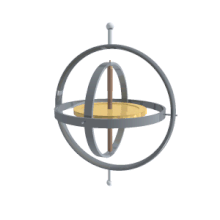
Back Kardanophanging Afrikaans ذات المحورين Arabic Suspensió de Cardan Catalan Kardanův závěs Czech Gimbal Danish Kardanische Aufhängung German Kardano Esperanto Suspensión cardán Spanish گیمبال Persian Gimbaali Finnish

A gimbal is a pivoted support that permits rotation of an object about an axis. A set of three gimbals, one mounted on the other with orthogonal pivot axes, may be used to allow an object mounted on the innermost gimbal to remain independent of the rotation of its support (e.g. vertical in the first animation). For example, on a ship, the gyroscopes, shipboard compasses, stoves, and even drink holders typically use gimbals to keep them upright with respect to the horizon despite the ship's pitching and rolling.
The gimbal suspension used for mounting compasses and the like is sometimes called a Cardan suspension after Italian mathematician and physicist Gerolamo Cardano (1501–1576) who described it in detail. However, Cardano did not invent the gimbal, nor did he claim to. The device has been known since antiquity, first described in the 3rd c. BC by Philo of Byzantium, although some modern authors support the view that it may not have a single identifiable inventor.[1][2]
- ^ Needham, Joseph. (1986). Science and Civilization in China: Volume 4, Physics and Physical Technology; Part 2, Mechanical Engineering. Taipei: Caves Books Ltd. Page 229.
- ^ Francis C. Moon, The Machines of Leonardo da Vinci and Franz Reuleaux: Kinematics of Machines from the Renaissance to the 20th century, p.314, Springer, 2007 ISBN 1-4020-5598-6.
© MMXXIII Rich X Search. We shall prevail. All rights reserved. Rich X Search